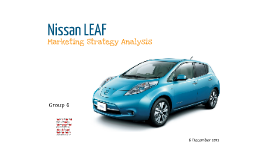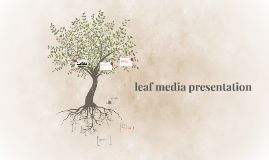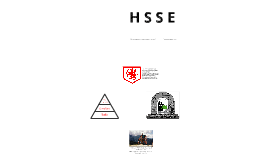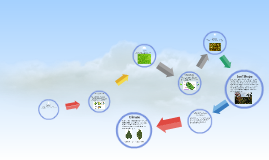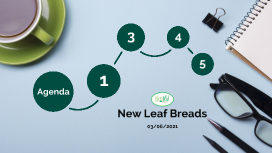Nissan LEAF Presentation
Transcript: Group 6 Non-Adopter Concerns over battery range and recharging infrastructures. (Synthesio, 2013) Question marks about running costs. (Synthesio, 2013) Doubts about the drive quality. (Synthesio, 2013) Main Nissan production facility in Tennessee. 3000+ dealers across US Physically-efficient supply chain vs. market-responsive process (Marshall, 2000) Nissan focused on supplying product at lower-possible cost, with low inventory But is the Nissan LEAF a “functional” product? Anderson, Narus, and van Rossum. Customer values propositions in Business Markets. Harvard Business Review: 1 March, 2006. Fuel-Efficient Mid-size Car (1) Re-evaluation of the importance consumers’ values (2) Re-evaluate “job for which product is hired” (Christensen) (3) Understand consumers’ purchase as more functionally-orientated (“shallower”) (4) Emphasize functionality, comfort, specifications AND environmental benefit Company Early Majority Nissan LEAF Nissan expects the cars to retain 76 % of the battery’s capacity after five years. This is not covered under the warranty that Nissan provides (Bullis, 2012). The lithium-ion battery pack in Nissan’s LEAF electric hatchback is vulnerable to heat. Resulting in a loss of range which is not acceptable to owners (Gordon-Bloomfield, 2013) . Targeting 6 December 2013 Three types of EV consumer (10 year forecast) (Deloitte, 2010): Political Company Context Zero Emissions Car Company With more research and incentives, we can break our dependence on oil with biofuels, and become the first country to have a million electric vehicles on the road by 2015” - President Barack Obama, 2011 State of the Union (Department Of Energy, 2011) 2009 Recovery Act established tax credits for purchasing electric vehicles ($2,500 - $7,500 per vehicle, depending on the battery capacity). (U.S Department of Transportation, 2012) Young Income > $200k Celebrities Southern CA "We will become the first county to have a million electric vehicles on the road by 2015", President Barack Obama, 2011 State of the Union Marketing Mix > $200k California Influencer: Customer Value Propositions: Company Perspective Competition Process - target environmentally minded people - families - people purchase to complete "job" of saving the world (1) Over-emphasized importance of environmental values (2) Misinterpreted the “job” for which consumers “hire” product (Christensen) (3) Positioned purchase of car as a “deep” decision (Yankelovich) (4) Erroneously assumed market’s acceptance of price premium P.E.S.T.L.E. Political: 1M cars by 2015 Recovery Act 2009; Tax credits up to $7,500 for EV's Economical: Rising fuel costs, economic crisis Environmental: The environmental movement 'Green' Car Collaborator Marketing Situation Analysis Recommendations NOTES: The Nissan leaf is the bestselling EV in the US Market. In 3 years, they changed their strategy successfully. Interesting case, because it shows that the complete marketing mix must be considered to market effectively. Pivot Environmental Customer Nissan Leaf 2010 launch Has failed to meet sales targets, Sameh Shehadeh Daniel Abadee Vittorio Gaddini Jesse Hoffman Niccolò Regoli Kyriacos Loizou Nicholas Scales About Place Source - (United States Environmental Protection Agency , 2011) Early Adopter Marketing Strategy Analysis Sources – (Nissan Sustainability Report , 2012) Price PESTLE Analysis Segmentation, Targeting & Positioning Customer Value Propositions Customer Perspective Economical Promotion Household Income: Gender: Location: Garage: Miles/week: Top Purchase Influence: Product The Alliance committed €4 billion (around US$5.2 billion) into its electric vehicle (EV) and battery development programs with the aim to become the leader in zero-emission transportation. Carlos Ghosn, Chairman and CEO of the Renault–Nissan Alliance predicted that by 2020 one in 10 new car sales will be an electric vehicle.[30][31] The first electric car based on this investment was the Nissan Leaf, launched in December 2010 in the United States and Japan. Between 2011 and 2012, Renault launched four BEVs, the Renault Kangoo Z.E. utility van, Renault Fluence Z.E., Renault Zoe, and the Renault Twizy urban quadricycle.[32] The Nissan Leaf is the world's top selling highway-capable all-electric car in history, and it passed the global sales milestone of 50,000 units in February 2013.[33] By July 2013 the Renault–Nissan Alliance is the world's leading plug-in electric vehicle manufacturer with global sales of 100,000 all-electric units delivered since December 2010, including more than 71,000 Nissan Leafs, about 11,000 Renault Twizys, almost 10,000 Kangoo Z.E. utility vans, about 5,000 Zoes, and over 3,000 Fluence Z.E. electric cars.[4][34] In May 2008, as part of the Alliance’s zero emission strategy, Nissan and NEC formed a joint-venture company, Automotive Energy Supply Corporation (AESC) to focus on the development and mass production of advanced lithium-ion batteries for a wide range of automotive






